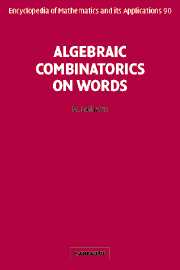Book contents
- Frontmatter
- Contents
- Preface
- Chapter 1 Finite and Infinite Words
- Chapter 2 Sturmian Words
- Chapter 3 Unavoidable Patterns
- Chapter 4 Sesquipowers
- Chapter 5 The Plactic Monoid
- Chapter 6 Codes
- Chapter 7 Numeration Systems
- Chapter 8 Periodicity
- Chapter 9 Centralizers of Noncommutative Series and Polynomials
- Chapter 10 Transformations on Words and q-Calculus
- Chapter 11 Statistics on Permutations and Words
- Chapter 12 Makanin's Algorithm
- Chapter 13 Independent Systems of Equations
- References
- Index of Notation
- General Index
Chapter 13 - Independent Systems of Equations
Published online by Cambridge University Press: 05 April 2013
- Frontmatter
- Contents
- Preface
- Chapter 1 Finite and Infinite Words
- Chapter 2 Sturmian Words
- Chapter 3 Unavoidable Patterns
- Chapter 4 Sesquipowers
- Chapter 5 The Plactic Monoid
- Chapter 6 Codes
- Chapter 7 Numeration Systems
- Chapter 8 Periodicity
- Chapter 9 Centralizers of Noncommutative Series and Polynomials
- Chapter 10 Transformations on Words and q-Calculus
- Chapter 11 Statistics on Permutations and Words
- Chapter 12 Makanin's Algorithm
- Chapter 13 Independent Systems of Equations
- References
- Index of Notation
- General Index
Summary
Introduction
The notion of a dimension, when available, is a powerful mathematical tool in proving finiteness conditions in combinatorics. An example of this is Eilenberg's equality theorem, which provides an optimal criterion for the equality of two rational series over a (skew) field. In this example a problem on words, i.e., on free semigroups, is first transformed into a problem on vector spaces, and then it is solved using the dimension property of those algebraic structures. One can raise the natural question: do sets of words possess dimension properties of some kind?
We approach this problem through systems of equations in semigroups. As a starting point we recall the well-known defect theorem (see Chapter 6), which states that if a set of n words satisfies a nontrivial relation, then these words can be expressed simultaneously as products of at most n — 1 words. The defect effect can be seen as a weak dimension property of words. In order to analyze it further one can examine what happens when n words satisfy several independent relations, where independence is formalized as follows: a set E of relations on n words is independent, if E, viewed as a system of equations, does not contain a proper subset having the same solutions as E.
It is not difficult to see that a set of n words can satisfy two or more equations even in the case where the words cannot be expressed as products of fewer than n—1 words.
Information
- Type
- Chapter
- Information
- Algebraic Combinatorics on Words , pp. 443 - 472Publisher: Cambridge University PressPrint publication year: 2002
Accessibility standard: Unknown
Why this information is here
This section outlines the accessibility features of this content - including support for screen readers, full keyboard navigation and high-contrast display options. This may not be relevant for you.Accessibility Information
- 2
- Cited by
